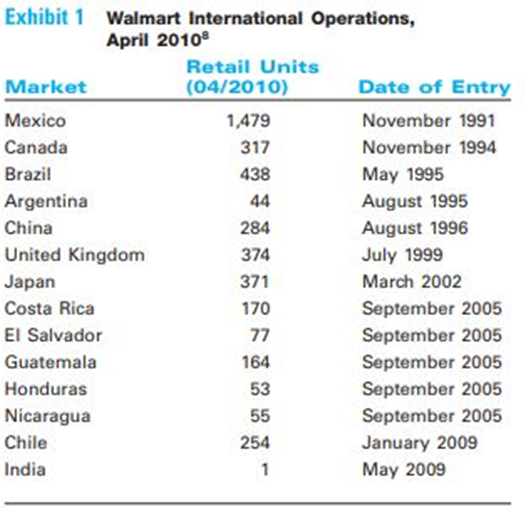Question
1. What was Walmart?s early global expansion strategy? Why did it choose to first enter Mexico and Canada rather than expand into Europe and Asia?
1. What was Walmart?s early global expansion strategy? Why did it choose to first enter Mexico and Canada rather than expand into Europe and Asia?
2. What cultural problems did Walmart face in some of the international markets it entered? Which early strategies succeeded and which failed? Why? What lessons did it learn from its experience in Germany and Japan?
3. How would you characterize Walmart?s Latin America strategy? What countries were targeted as part of this strategy? What potential does this region bring to Walmart?s future global expansion? What cultural challenges and opportunities has Walmart faced in Latin America?
4. What group of countries will be targeted for Walmart?s future growth? What are the attractiveness and risk profiles of these countries? What regions of the world do you think will be vital for Walmart?s future global expansion?
In 1991, Walmart became an international company when it opened a Sam's Club near Mexico City. Just two years later, Walmart International was created. Since venturing into Mexico in 1991, Walmart International has grown somewhat erratically. During the 1990s the retailer exported its big-box. low-price model, an approach the company expected to be as successful in foreign markets as it was in the United States. Although Walmart has had success in several overseas markets, this success has been far from universal. For example. in Mexico, China, and the U.K., the company's efforts to offer the lowest price to custom-ers backfired because of resistance from established retail-ers. And in Germany, Walmart could not seem to fit its model to local tastes and preferences. In Japan, its joint venture had a series of setbacks, many related to buying habits for which the Walmart model did not respond well. In Mexico. three of the largest domestic retailers con-structed a joint buying and operational alliance solely to compete with Walmart.I Its presence in Hong Kong ended after only two years during the 1990s, and it shuttered operations in Indonesia in the mid-1990s after rioting incidents in Jakarta. Walmart also owned approximately 16 stores in South Korea and 85 in Germany; however, it sold off these operations in 2006 after merchandise failed to match consumer tastes, distribution and re-bagging problems arose, and strong loyalties to other brands made attracting customers difficult and expensive! In addition, labor advocates and environmentalists have created headaches for the U.S. behemoth, making continued expansion both cumbersome and expensive. For instance, in 2006, Walmart faced a strong public relations campaign from the MI-China Federation of Trade Unions (ACFTU) over Walmart's refusal to let its workers in China unionize. Walmart was eventually forced to con-cede, perhaps because the Chinese government also lent its weight to the ACFTU's campaign in its effort to estab-lish unions in all foreign-funded enterprises throughout the country. As of October 2006, almost 6,000 of Walmart China's 30.000 employees were union members.: Despite its public battle with the ACFTU, Fortune China and Watson Wyatt still voted Walmart China as one of the "Top 10 Best Companies to Work for" in 2005' As Walmart continues to expand its global operations, ana-lysts are curious to see how the company is received and whether consumers' opinions in fragmented market set-tings are a match with Walmart's low price model. 
Exhibit 1 Walmart International Operations, April 2010 Market Mexico Canada Brazil Argentina China United Kingdom Japan Costa Rica El Salvador Guatemala Honduras Nicaragua Chile India Retail Units (04/2010) 1,479 317 438 44 284 374 371 170 77 164 53 55 254 1 Date of Entry November 1991 November 1994 May 1995 August 1995 August 1996 July 1999 March 2002 September 2005 September 2005 September 2005 September 2005 September 2005 January 2009 May 2009
Step by Step Solution
3.43 Rating (153 Votes )
There are 3 Steps involved in it
Step: 1
1 Walmart opted for Internationalization as the early global expansion strategy At that time Walmart however did not have the required financial organizational and managerial resources to go for inter...
Get Instant Access to Expert-Tailored Solutions
See step-by-step solutions with expert insights and AI powered tools for academic success
Step: 2

Step: 3

Ace Your Homework with AI
Get the answers you need in no time with our AI-driven, step-by-step assistance
Get Started


